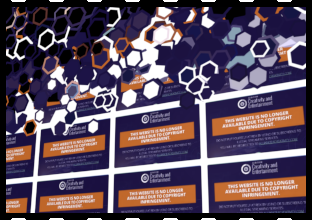France: Streaming & DDL Piracy Fall But Cloud & Usenet Boosts Wipe Out Gains

For more than a decade, the French government has produced a report detailing the digital content consumption habits of French internet users.
Currently produced by telecoms regulator Arcom, the content consumption barometer report quantifies consumption of major content categories including movies, TV shows, live sports broadcasts, music, video games, software, and audiobooks, among others. It aims to profile consumers of content, map changes in consumption habits and sources, and gauge public perception of legal content availability. Arcom published the report’s 2023 edition yesterday.
Overall Exposure to Cultural Content
In terms of overall exposure to digital cultural and sporting content, the report estimates that 87% of internet users aged 15 and over, around 45 million people, were consumers in 2023. That’s up from 86% in 2022.
Of the dozen content categories covered in the report, movies were consumed by 55%, music by 50%, and TV series by 49%, meaning no change in the most popular content categories consumed in 2023 versus last year.
Paying (And Not Paying) For Content
For 2023, Arcom reports that 61% of consumers or 27.5 million people, paid to consume digital content online. This year the average monthly spend was €38.00 ($41.00) per month, a significant increase from the €32.00 ($34.50) reported in 2022. The report notes that this is the biggest increase in average spending in recent years, with Arcom describing the uplift as “remarkable” in the context of price inflation.
One of Arcom’s key responsibilities is to reduce piracy rates. In 2021, around 27% of internet users consumed at least one piece of pirated content, a figure that reduced to 24% in 2022.
Arcom introduces 2023’s overall piracy rate as follows: “The fall observed in 2022 in the proportion of illegal consumption of digital cultural and sporting content has continued this year,” while later adding, “..this continues the decline seen in 2022.”
While this year’s figures are provided, the “fall observed in 2022” was actually the difference between an overall rate of 27% in 2021 and 24% in 2022, in other words a three percentage point reduction in the overall piracy rate, aka success. Perhaps a less ambiguous statement would’ve been more helpful to describe the state of play this year.
In 2023 there was zero reduction in the overall piracy rate, i.e. the rate is static year-on-year. In common with 2022, in 2023 around 24% of internet users still consumed at least one piece of pirated content. The report describes this as illegal content consumption “leveling off.”
Appetite For Piracy Wanes With Age
In common with most other studies conducted in Europe, piracy rates are higher among younger people in France and lower among the older generations.
“The 15-24 and 25-39 age groups are the biggest consumers of illegal digital cultural and sporting content (46% and 36% respectively). Conversely, only 16% of 40–59-year-olds and 7% of 60+ year-olds are involved,” the report notes.
When drilling down into content categories, the report says that a drop in illegal consumption was observed in a quarter.
“This is particularly the case for films and music, two of the three content categories with the highest levels of illegal consumption by internet users in 2022 (-1 point each, to 12% and 6% of internet users respectively),” Arcom reports.
“While illegal consumption of TV series, the second most pirated content in 2022, remains stable in 2023 within the internet user population (9% illegal consumption), there has been a slight fall among those who consume it (18%, -1 point).”
Consumption of Illegal Streams & Downloads Fall
The two most popular methods of obtaining infringing content in France are streaming and direct downloading, often referred to as DDL. However, this year’s report from Arcom finds that both methods experienced declining popularity in 2023.
While remaining the most frequently used method among consumers overall (49% and 38% respectively), streaming fell two percentage points and downloading four percentage points versus rates in 2022.
Arcom says that these declines in two key categories demonstrate “the positive effects of the anti-piracy measures implemented in 2022 and 2023.” While that may well be the case, if overall piracy rates remained static this year, something else must’ve taken up the slack.
As the Arcom graph shows, remarkable gains are on display in two categories. In 2022, services in the ‘Usenet and newsgroups’ category were used by 11% of French internet users but in 2023, that figure has increased to 16%. The other category climbing quickly, Cloud services, reached a peak of 21% in 2020 and then fell to 19% and 16% in 2021 and 2022 respectively.
In 2023, improved privacy versus other illicit content access methods may have contributed to Cloud services’ 2020-equalling usage rate of 21%.
Illegal Access Rates Overall
Arcom reports a “stabilization” in illicit consumption of live sports broadcasts for 2023. This year’s rate of 4% is identical to that reported in 2022, but still an improvement over 2021 where 6% of internet users consumed liver sports from illegal sources.
In summary, illegal streaming was used by 49% of internet users in 2023, direct downloading (DDL) by 38%, social networks by 32%, with peer-to-peer networks such as BitTorrent hanging on to around 26% of users.
The surprise package of Usenet (16%) and Cloud services (21%) returning to rates not seen since 2020 might be the trend to watch since Arcom has much less control over these methods. Deterring the use of streaming and downloading services may be considered a success, but that could be tempered if more complex issues are encountered further down the road.
Arcom’s 2023 Barometer report is available here (pdf, French)
From: TF, for the latest news on copyright battles, piracy and more.
TorrentFreak




